
Brachymeles is a genus of skinks. The majority of the species within the genus are endemic to certain island ecosystems in the Philippines. In 2018, the Zoological Society of London through its EDGE of Existence Program listed the Cebu small worm skink as the 80th most evolutionarily distinct and globally endangered reptile species in the world, making it the most endangered member of the genus Brachymeles.

Ophiomorus is a genus of Old World skinks. The limbs are either reduced or absent, depending on the species. They are sometimes known as limbless skinks or snake skinks. Members of the genus live under rocks or in burrows.

The eastern brown snake, often referred to as the common brown snake, is a species of highly venomous snake in the family Elapidae. The species is native to eastern and central Australia and southern New Guinea. It was first described by André Marie Constant Duméril, Gabriel Bibron, and Auguste Duméril in 1854. The adult eastern brown snake has a slender build and can grow to 2 m (7 ft) in length. The colour of its surface ranges from pale brown to black, while its underside is pale cream-yellow, often with orange or grey splotches. The eastern brown snake is found in most habitats except dense forests, often in farmland and on the outskirts of urban areas, as such places are populated by its main prey, the house mouse. The species is oviparous. The International Union for Conservation of Nature classifies the snake as a least-concern species, though its status in New Guinea is unclear.

Dieurostus is a genus of snake in the family Homalopsidae. The genus Dieurostus is monotypic, containing only the species Dieurostus dussumieri, commonly known as Dussumier's water snake, or Kerala mud snake. The species, which is mildly venomous and rear-fanged, is endemic to Kerala, in southwestern India. It was formerly thought to be found in Bangladesh, although its distribution there is now disputed.

Xylophis perroteti, commonly known as Perrotet's mountain snake and the striped narrow-headed snake, is a species of snake in the family Pareidae. The species is endemic to the Western Ghats of India.

Pseudocerastes is a genus of venomous vipers endemic to the Middle East and Asia. It was originally a monotypic genus created in 1896 by Boulenger for the species Pseudocerastes persicus, but three species are now recognised: the spider-tailed horned viper ; Persian horned viper and Field's horned viper.
Dromophis is a genus of colubrid snakes. There are two commonly accepted species in the genus Dromophis:
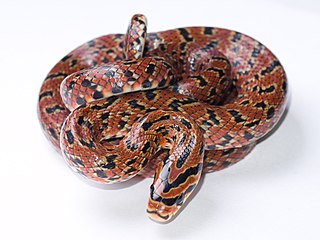
Euprepiophis conspicillata, commonly known as the Japanese forest rat snake, is a species of nonvenomous colubrid snake endemic to Japan. Its Japanese common name, jimuguri, roughly translates to "the burrower". It is closely related to Euprepiophis mandarinus, the Mandarin rat snake.

Plectrurus perrotetii, commonly known as the Nilgiri burrowing snake or Perrotet's shieldtail, is a species of harmless snake in the family Uropeltidae. The species is endemic to India.
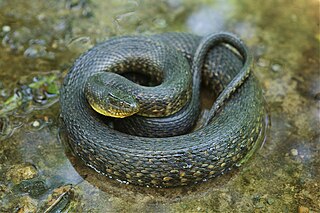
The green water snake is a common species of nonvenomous natricine snake endemic to the southeastern United States.
The striped swamp snake, also known as the African swamp snake, is a species of colubrid snake. It is one of two members of the genus Dromophis. It is found in several African countries, including Burkina Faso, Senegal, Guinea-Bissau, Mali, Ivory Coast, Togo, Ghana, Benin, Niger, Nigeria, and Cameroon.

Hydrophis peronii, commonly known as the horned sea snake, Peron's sea snake, and the spiny-headed seasnake, is a species of venomous snake in the subfamily Hydrophiinae of the family Elapidae. The species is endemic to the western tropical Pacific Ocean. It is the only sea snake with spines on the head. Like all other members of the family Elapidae, it is venomous. It is sometimes placed in its own genus Acalyptophis.
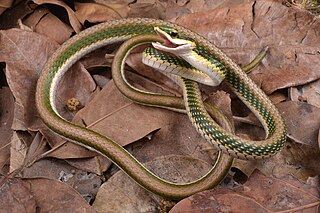
Leptophis mexicanus, commonly known as the Mexican parrot snake, is a species of medium-sized slender snake in the family Colubridae. The species is endemic to the Americas.

Ithycyphus miniatus is a species of venomous snake in the family Pseudoxyrhophiidae. The species is native to Madagascar.
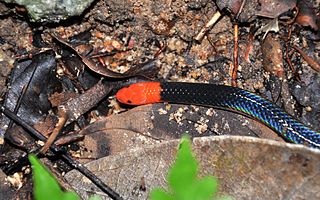
Calamaria schlegeli is a species of snake in the family Colubridae. The species is known commonly as the red-headed reed snake, white-headed reed snake, and pink-headed reed snake. It is native to Southeast Asia, where it occurs in Brunei, Indonesia, Malaysia, and Singapore.

Calamaria gervaisii, commonly known as Gervais' worm snake, is a species of relatively small-sized burrowing or fossorial snake in the family Colubridae.

The golden-crowned snake is a small species of venomous snake in the family Elapidae. The species is endemic to Australia.
Stegonotus is a genus of snakes in the family Colubridae.
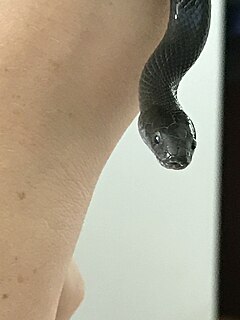
Lycodonomorphus inornatus, commonly known as the olive house snake, the black house snake, and the olive ground snake, is a species of nonvenomous snake in the family Lamprophiidae. The species is endemic to southern Africa. It is a nocturnal snake with terrestrial habits.
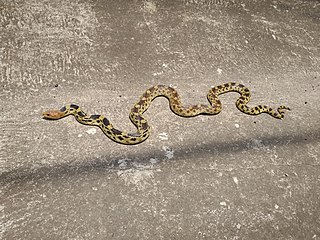
Pituophis deppei, commonly known as the Mexican bullsnake and the Mexican pine snake, is a species of snake in the family Colubridae. The species is endemic to Mexico. There are two recognized subspecies.



















